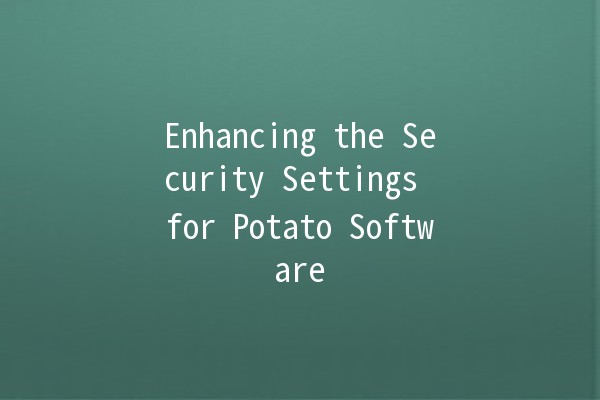In an era where digital privacy and security are crucial, ensuring that our software applications are properly configured is more important than ever. "Potato" software, a popular tool among users for its userfriendly interface and versatile functionality, also requires attention to its security settings. This article will delve deep into practical recommendations for enhancing the safety of Potato Software's Chinese version while maintaining optimal productivity.
Understanding Security Risks
Before diving into the protection measures, it's essential to understand the common security risks associated with software applications. These may include unauthorized access, data breaches, malware infections, and phishing attacks. By recognizing these potential threats, users can better prepare themselves to implement effective safeguards.
Common Security Risks in Software Applications

Recognizing these threats is the first step toward implementing safety strategies. Below are five specific tips to enhance the security settings of Potato Software.
Explanation:
TwoFactor Authentication adds an extra layer of security by requiring not just a password and username but also something that only the user has on them, such as a physical token or a mobile device app that generates a second code.
Practical Application:
To enable 2FA on Potato Software, navigate to the security settings within the application. From there, follow the prompts to link your mobile device and configure your preferred authentication method. By requiring a second form of identification, even if a password is compromised, the account remains secure.
Example:
Suppose a user with a commonly used password faces a data breach. Even if the hacker obtains the password, they would still need the second factor (like a phone verification code) to gain access, effectively safeguarding user data.
Explanation:
Keeping your software uptodate is crucial as updates often patch security vulnerabilities that could be exploited by attackers.
Practical Application:
Set Potato Software to automatically check for updates and install them as they become available. You can find this option in the software’s settings menu under the “Updates” section.
Example:
Consider a recent vulnerability discovered in Potato Software that could allow unauthorized access. By ensuring that the software is updated regularly, users can avoid exploitation of this weakness since the patch will close the security gap.
Explanation:
Potato Software allows users to adjust their privacy settings to limit the amount of personal information shared and enhance overall security.
Practical Application:
In the settings menu, users should review the privacy options. Disable any features that access unnecessary personal information, and ensure that sharing options are set to the minimum required for functionality.
Example:
If Potato Software requests access to your contact list for sharing features, consider whether this is essential. By limiting access, you can reduce the risk of inadvertent data leakage.
Explanation:
A strong password is the first line of defense against unauthorized access. Weak passwords can be easily guessed or cracked.
Practical Application:
Implement a password policy that requires complex passwords with a combination of letters, numbers, and symbols. Utilize password managers to generate and store unique passwords for each account.
Example:
Instead of using "123456" or "password," use a passphrase like "PotatoRocks2023!", which is easier to remember and significantly harder for others to guess. Always change passwords regularly and avoid reusing old passwords.
Explanation:
Frequent backups protect important data against loss from attacks such as ransomware, which may threaten to delete or hold your data hostage.
Practical Application:
Use Potato Software’s builtin backup feature to schedule regular backups. Store these backups in a secure location, such as an external hard drive or a reputable cloud service known for its security features.
Example:
Imagine a scenario where Potato Software is compromised, and user data is deleted. If regular backups are in place, the user can restore the lost data quickly, minimizing disruption.
Frequently Asked Questions
Creating a secure password involves using a minimum of 1216 characters, including uppercase and lowercase letters, numbers, and symbols. Avoid using personal information or common words. Utilize password management tools for greater security.
Phishing attempts often include unexpected emails that contain links or attachments. Look for inconsistent or suspicious sender details, poor grammar, and urgent calls to action. Always verify the sender's authenticity before clicking on links.
Immediately change your password, enable twofactor authentication if not already active, and monitor your account activity for any unauthorized transactions. It's also wise to inform the software provider about the security breach.
Yes, you can explore biometric authentication methods like fingerprint scanning or facial recognition, which offer a high level of security without needing secondfactor codes.
Updating your software regularly is crucial, ideally every time a new update is released. If automatic updates are enabled, it will streamline this process, ensuring that you constantly have the latest security patches.
Be cautious with unexpected update notifications. Verify the software publisher and go directly to the official website to check for updates rather than clicking on links in unsolicited messages.
By integrating these security practices, users can significantly enhance the safety and usability of Potato Software. The comfort of knowing that your digital environment is secure empowers you to focus on productivity and creativity without unnecessary stress.